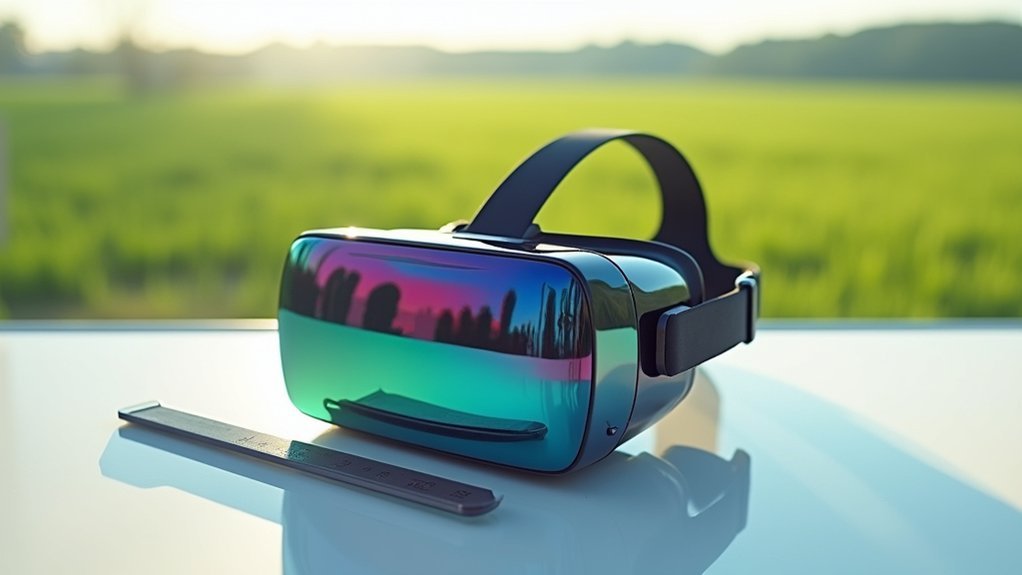You’ll expand your peripheral vision by positioning your VR headset snugly against your face and adjusting interpupillary distance settings to match your eye spacing. Practice dynamic eye movement training by tracking moving objects in virtual environments and detecting stimuli outside your direct line of sight. Start with static object detection, then progress to moving targets and multi-stimulus scenarios. Upgrade to headsets with wider field-of-view capabilities and integrate auditory feedback with visual cues for enhanced spatial awareness and detection.
Optimize VR Headset Positioning for Maximum Field Coverage

While many VR users focus primarily on graphics and performance, you’ll discover that proper headset positioning dramatically impacts your peripheral vision and overall immersion.
Position the headset snugly against your face to eliminate gaps that restrict your field of view. Adjust the interpupillary distance settings to match your eye distance, reducing eye strain while maximizing peripheral awareness.
Proper headset positioning eliminates visual gaps and optimizes interpupillary distance settings for enhanced peripheral awareness and reduced eye strain.
Tilt the headset slightly downward to minimize light leakage and expand coverage beyond your central point of focus. Since vision plays a vital role in spatial awareness, utilize adjustable straps to prevent slippage during movement.
Experiment with different angles in well-lit conditions to improve your peripheral vision. If persistent discomfort occurs, consult an eye care professional for personalized adjustments.
Dynamic Eye Movement Training in Virtual Environments
Because virtual environments offer unlimited control over visual stimuli, you can train your eye movements more effectively than traditional methods allow.
Dynamic eye movement training in these settings lets you track moving objects while strengthening your peripheral vision through immersive scenarios. Virtual environments challenge you to detect stimuli outside your direct line of sight, gradually expanding your field of view.
These exercises enhance responsiveness and spatial awareness by requiring rapid focus shifts between central and peripheral targets.
You’ll experience improved reaction times through consistent practice, with studies showing up to 25% increases in peripheral awareness. The neural pathways you develop translate directly to real-world applications, boosting performance in sports, driving, and daily activities requiring enhanced visual processing skills.
Progressive Peripheral Awareness Exercises Using VR Applications

Progressive peripheral awareness exercises through VR applications transform your visual training by creating structured challenges that systematically expand your field of awareness. These immersive environments enable you to improve peripheral vision while maintaining central focus on primary targets. VR applications offer gamified exercises and techniques that enhance object detection skills through 360-degree visual field exposure.
| Training Level | Exercise Focus | Key Benefits |
|---|---|---|
| Beginner | Static object detection | Basic peripheral awareness |
| Intermediate | Moving target tracking | Enhanced reaction times |
| Advanced | Multi-stimulus scenarios | Superior spatial awareness |
| Expert | Complex environment navigation | Real-world application readiness |
Regular practice with these progressive exercises creates measurable improvements in your reaction times and spatial awareness, directly benefiting activities like sports and driving through enhanced peripheral vision capabilities.
Hardware Modifications to Expand Virtual Reality Visual Range
Since hardware limitations often constrain your peripheral vision training in VR, strategic modifications can dramatically expand your visual range and enhance the effectiveness of your exercises.
You’ll want to upgrade to headsets offering up to 210° FOV compared to standard 100° field limitations. Choose lenses with aspherical designs to reduce edge distortion and improve peripheral clarity.
Adding external sensors enhances tracking accuracy for smoother, more responsive movement detection. Optimize your headset fit using adjustable straps and face pads to eliminate light leaks that break immersion.
Consider integrating eye-tracking technology, which efficiently allocates graphical resources while expanding your peripheral visual field.
These modifications create a more immersive experience that maximizes your peripheral awareness training potential.
Multi-Sensory Integration Techniques for Enhanced Spatial Detection

Although your eyes capture visual information in your peripheral field, integrating multiple sensory inputs creates a more thorough spatial detection system that dramatically enhances your awareness of surrounding environments.
Multi-sensory integration combines visual input with auditory feedback and tactile cues to detect motion more effectively than relying on sight alone.
You’ll enhance peripheral awareness by practicing activities requiring simultaneous sensory processing. Playing musical instruments trains your brain to coordinate visual, auditory, and tactile information.
Team sports develop rapid environmental assessment skills through multi-modal stimulation.
Virtual reality technology provides controlled training environments where you’ll process complex sensory combinations. These exercises improve reaction times and decision-making by challenging your spatial awareness systems.
Regular mindfulness practice focusing on sensory interplay sharpens your ability to respond quickly to environmental changes.
Frequently Asked Questions
How Do I Widen My Peripheral Vision?
You’ll improve peripheral vision by practicing wall exercises where you focus centrally while identifying side objects, doing sports drills with fixed focus points, and using mindfulness techniques like Hakalau meditation.
How Do You Expand Your Field of Vision?
You’ll expand your field of vision by practicing peripheral awareness exercises, using training tools like light boards, performing sports drills, and regularly challenging your visual limits through dynamic movements while maintaining central focus.
Which Gives You a Wider Perspective Peripheral Vision?
You’ll gain wider perspective through peripheral vision by practicing eye exercises that engage your outer visual field. Track moving objects, play sports requiring spatial awareness, and consciously widen your gaze during daily activities.
What Are Glasses That Widen the Visual Field of Vision?
You’ll find peripheral vision glasses use prism technology and high-index lenses to expand your visual field. They’re specifically designed for athletes and drivers, helping you see objects outside your direct line of sight without moving your head.





Leave a Reply